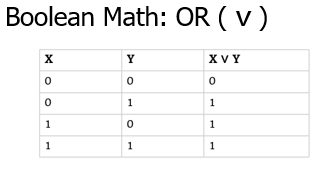Today we are going to take another look at some Boolean mathematics. In particular, we’re going to focus on the OR operational logic, as covered in Domain 3 of the CISSP common body of knowledge (CBK).
As a brief recap, Boolean math is based on a binary system. As such, there are only two values that we can have. The value will either be a 1, or it will be a 0. Where 1 is equal to a True condition and 0 is equal to a False condition.
The OR operation is symbolized by the ∨ symbol, and when you see this symbol on a Boolean math problem, then you will need to apply the OR operational logic.
Next, we want to define how the OR logic works. To apply the OR logic, we need to compare between two value and check to see if at least one of them is set to True, or 1. If one (or both) of the values is equal to 1, then the result is also equal to 1.
Below is the truth table for the OR logic. Again, one of the nice things about dealing with binary, is that it’s easy to map out the different combinations of 0 and 1.

Similar to the last Boolean article, there’s a good possibility that the CISSP exam may require you to solve a Boolean math problem. So, we are going to use the example problem below and apply the OR logic to solve the problem.
Example Boolean Problem:
X: 0 1 1 0 0 1 0 1
Y: 1 0 1 0 0 1 1 0
__________________________
X ∨ Y:
Whenever you’re faced with a Boolean problem, the first thing you want to do is verify what type of logic to apply. In the example above, we see that it is using the ∨ symbol, so we’re going to use the OR logic here.
Next, we compare the X and Y values in each column. So, starting with the first column we’ll reference the OR logic and ask ourselves, “Is at least one of the values equal to 1?”. If so, then the result will be 1, otherwise, the result will be 0.

Continue to work down each column in the problem and apply the OR operational logic to each pair of X/Y values, and the final answer should look like this:

You can create additional practice problems by making a random set of 0’s and 1’s for X and Y, and then solve them using the OR logic. Hopefully this has been helpful for identifying how the OR logic works or if you’re faced with this type of question on your CISSP exam.
This has been a quick look at the OR Boolean logic. There is an audio/video version of this material, for anyone who prefers that format. If you’re interested in security fundamentals, we have a Professionally Evil Fundamentals (PEF) channel that covers a variety of technology topics. We also answer general basic questions in our Knowledge Center. Finally, if you’re looking for a penetration test, training for your organization, or just have general security questions please Contact Us.